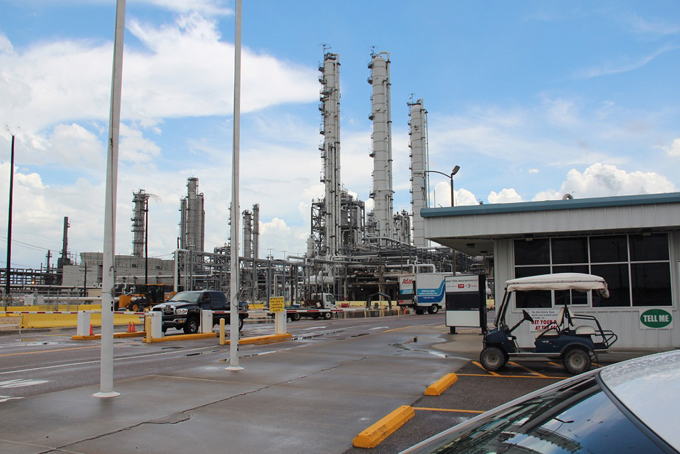
The BASF petrochemical plant in Port Arthur, Texas, was recently renovated so it could use shale gas to make plastic. (Photo by Reid R. Fraiser/The Allegheny Front)
by Reid R. Frazier
Allegheny Front
PORT ARTHUR, Texas — Standing beneath a tangle of pipes, ductwork, and grated catwalks at BASF’s massive ethylene unit in this small refining city on the Gulf Coast, Andy Miller pointed to a large metal box a few feet above his head. Inside, a fire burning at 2,000 degrees Fahrenheit produced an industrial-scale whine.
“If you look up into this little peephole, you’ll be able to see some of the firing,” Miller said.
The orange glow is just one sign of an historic transformation occurring in the U.S. chemical industry and stretching from Western Pennsylvania to the Texas coast. The plant was recently modified to pipe ethane—a key component found in natural gas, especially in shale formations—through its furnaces.
The plant can make more than two billion of pounds a year of ethylene, a key component of plastic that’s used in everything from diapers to antifreeze to plastic bags.
This is where the building blocks for those products begin, said Miller, a manager for BASF. “It starts here.”
Miller’s plant is one of several around the country that have expanded to take advantage of shale gas. In addition, six brand new “world-scale” crackers — where ethane is ‘cracked’ to separate out the ethylene — are slated for construction in Texas and Louisiana.
Royal Dutch Shell has proposed building a cracker plant in Western Pennsylvania, in the heart of the ethane-rich Marcellus Shale. It would be the first ethane cracker of its size in the Appalachian region. The company has a land option for a property in Monaca, Pa., in Beaver County and has recently solicited bids for contracts from local ethane producers while it evaluates the site.
The state has promised more than $1 billion in tax breaks over 25 years to the project, which Shell said could provide up to 10,000 jobs at the height of construction.
Jason Warrior, 28, with his daughter Makayla, came to Port Arthur, Texas, to find a job in one of the city’s many refineries and chemical plants. Thus far he has been unsuccessful. (Photo by Reid R. Fraiser/The Allegheny Front)
A key switch
It wasn’t so long ago that Miller’s employer, BASF, couldn’t have used any natural gas here. The plant was built in the 1990s to convert naptha—a crude oil byproduct—into ethylene. It was one of the biggest such facilities in the world, capable of making 2.45 billion pounds of ethylene, enough to make a quarter trillion of plastic bags a year.
But in the late 2000s, the “shale gale” flipped the script for the U.S. chemical industry. Once $12 per thousand cubic feet, natural gas dropped to between $3 and $4. Almost overnight, the shale gas revolution made the U.S. one of the cheapest places in the world to make plastic. The industry took note, and went on its current building boom.
Fracking, the horizontal drilling process used to extract natural gas from shale, has completely revived the prospects of the American chemical industry, experts say.
“It is a huge deal,” says Joe Chang, global editor of ICIS Chemical Business, a trade weekly. “It’s a great amount of expansion, all based on the premise that you’re going to have these low-cost natural gas feedstocks for a long time.”
ICIS estimates that the U.S. capacity to make ethylene—the “big daddy” of petrochemicals—will expand by a whopping 38 percent in the next few years, with plants planned from Freeport, Texas, to Louisiana to Beaver County, Pa.
“It really has changed everything for the U.S. chemical sector,” Chang said.